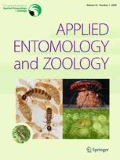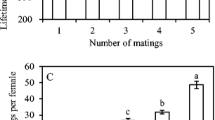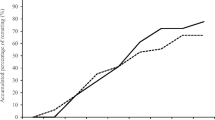Abstract
To clarify whether multiple mating of females and males affects the reproductive performance of the rice leaffolder moth, Cnaphalocrocis medinalis (Guenée), we examined the effect of the number of matings (once, twice, or three times) for females (female treatment) and males (male treatment) on the incidence of moth mating, number of eggs laid, egg hatchability, and adult longevity. We also compared the effect of multiple mating imposed on males or females separately with the effect of that imposed on both sexes simultaneously (both sexes treatment). The incidence of mating of females and males that mated three times (3-mated females and males) was significantly lower than for females and males that mated twice or once (2-mated or 1-mated females and males). The incidence of mating of 1-mated moths (both sexes) was significantly higher than for 2-mated or 3-mated moths (both sexes). Two-mated or 3-mated females laid significantly more eggs with significantly higher hatchability than 1-mated females. Females that mated with 1-mated males (second male mating) or 2-mated males (third male mating) laid significantly fewer eggs than those that mated with virgin males (first male mating). Females laid significantly more eggs after the second and third matings for moths of both sexes than after the first mating for moths of both sexes. The mechanisms of improvement and decline of female reproductive performance when multiple mating was imposed on males or females are also discussed in relation to the reproductive biology of C. medinalis.
Similar content being viewed by others
References
Arnqvist G, Nilsson T (2000) The evolution of polyandry: multiple mating and female fitness in insects. Anim Behav 60:145–164
Bissoondath CJ, Wiklund C (1996) Male butterfly investment in successive ejaculates in relation to mating system. Behav Ecol Sociobiol 39:285–292
Blanckenhorn WU, Hosken DJ, Martin OY, Reim C, Teuschl Y, Ward PI (2002) The costs of copulating in the dung fly Sepsis cynipsea. Behav Ecol 13:353–358
Chapman T, Davies SJ (2004) Functions and analysis of the seminal fluid proteins of male Drosophila melanogaster fruit flies. Peptides 25:1477–1490
Cook PA (1999) Sperms numbers and female fertility in the moth Plodia interpunctella (Hübner) (Lepidoptera: Pyralidae). J Insect Behav 12:767–779
Delisle J, Bouchard A (1995) Male larval nutrition in Choristoneura rosaceana (Lepidoptera: Tortricidae): an important factor in reproductive success. Oecologia 104:508–517
Drummond BC (1984) Multiple mating and sperm competition in the Lepidoptera. Smith RL Sperm competition and the evolution of animal mating systems. Academic, New York, pp 291–370
Edvardsson M, Arnqvist G (2000) Copulatory courtship and cryptic female choice in red flour beetles Tribolium castaneum. Proc R Soc Lond B 267:559–563
Eliyasu D, Nagalakshmi V, Kubli E, Choffat Y, Applebaum SW, Rafaeli A (2003) Inhibition of pheromone biosynthesis in Helicoverpa armigera by pheromonostatic peptides. J Insect Physiol 49:569–574
Fan Y, Rafaeli A, Moshitzky P, Kubli E, Choffat Y, Applebaum SW (2000) Common functional elements of Drosophila melanogaster sex peptide stimulates juvenile hormone biosynthesis and depresses sex pheromone production in Helicoverpa armigera. Insect Biochem Mol Biol 30:805–812
Foster SP, Ayers RH (1996) Multiple mating and its effects in the light brown apple moth, Epiphyas postivittana (Walker). J Insect Physiol 42:657–667
Halliday T, Arnold SJ (1987) Multiple mating by females: a perspective from quantitative genetics. Anim Behav 35:939–941
Helversen DV, Helversen OV (1991) Pre-mating sperm removal in the bush cricket Metaplastes ornatus Ramme (Orthoptera, Tettigonidae, Phaneropteridae). Behav Ecol Sociobiol 28:391–396
Hou M, Sheng C (1999) Fecundity and longevity of Helicoverpa armigera (Lepidoptera: Noctuidae): effects of multiple mating. J Econ Entomol 92:569–573
Inoue H, Kamiwada H, Fukamachi S (2004) Seasonal changes in adult density and female mating status of the rice leaf roller Cnaphalocrocis medinalis (Lepidoptera: Pyralidae) in paddy fields of Southern Kyushu, Japan. Japanese J Appl Entomol Zool 48:177–183 (in Japanese with English summary)
Ishiguri Y (2012) Mating frequency and reproductive performance of females in peach fruit moth, Carposina sasakii. An Rep Soc Pl Prot North Jpn 63:205–208 (in Japanese with English summary)
Jiménez-Pérez A, Wang Q, Markwick N (2003) Remating behavior of Cnephasia jactatana Walker females (Lepidoptera: Tortricidae). J Insect Behav 16:797–809
Kaitala A, Wiklund C (1995) Female mate choice and mating costs in the polyandrous butterfly Pieris napi (Lepidoptera: Pieridae). J Insect Behav 8:355–363
Kamiwada H, Tanaka A, Haruguchi T (1994) Mass immigration and occurrence of the rice leafroller, Cnaphalocrocis medinalis Guenée, in Kagoshima prefecture in 1993. Proc Assoc Pl Prot Kyushu 40:98–101 (In Japanese)
Kawagoe T, Suzuki N, Matsumoto K (2001) Multiple mating reduces longevity of females of the windmill butterfly Atrophaneura alcinous. Ecol Entomol 26:258–262
Kawazu K, Tatsuki S (2002) Diel rhythms of calling behavior and temporal change in pheromone production of the rice leaffolder moth, Cnaphalocrocis medinalis (Lepidoptera: Crambidae). Appl Entomol Zool 37:219–224
Kawazu K, Suzuki Y, Yosiyasu Y, Castillon F, Ono H, Vuong PT, Kuan HF, Adati T, Tatsuki S et al (2005) Sex pheromone of the rice leaffolder moth, Cnaphalocrocis medinalis (Lepidoptera: Crambidae): comparison of attractiveness in the China, Vietnam and South Philippine of the three synthetic pheromone blends. Appl Entomol Zool 40:483–488
Kawazu K, Otuka A, Adati T, Tonogouchi H, Yase J (2008) Lepidoptera captured on the East China Sea in 2005 and predicted migration sources. Entomol Sci 11:315–322
Keller L, Reeve HK (1995) Why do females mate with multiple males? The sexually selected sperm hypothesis. Adv Study Behav 24:291–315
Kingan TG, Thomas-Laemont PA, Raina AK (1993) Male accessory gland factors elicit change from ‘virgin’ to ‘mated’ behaviour in the female corn earworm moth Helicoverpa zea. J Exp Biol 183:61–76
Kingan TG, Bodnar WM, Raina AK, Shabanowitz J, Hunt DF (1995) The loss of female sex pheromone after mating in the corn earworm moth Helicoverpa zea: identification of a male pheromonostatic peptide. PNAS 92:5082–5086
Knight AL (2007) Multiple mating of male and female coldling moth (Lepidoptera: Tortricidae) in apple orchards treated with sex pheromone. Environ Entomol 36:157–164
Michereff MFF, Vilela EF, Filho MM, Nery DMS, Thièbaut JT (2004) Effects of delayed mating and male mating history on the reproductive potential of Leucoptera coffeella (Lepidoptera: Lyonetiidae). Agric For Entomol 6:241–247
Michiels NK, Newman LJ (1998) Sex and violence in hermaphrodites. Nature 391:647
Miyahara Y (1980) The mating rate of Cnaphalocrocis medinalis Guenée collected on the East China Sea. Ann Rept Plant Prot North Jpn 31:107–109
Miyahara Y (1995) Seasonal changes in adult density and mating rate of the rice leaffolder moth, Cnaphalocrocis medinalis Guenée, on vegetation around rice fields and a coastal area. Proc Assoc Pl Prot Kyushu 41:69–73
Miyahara Y, Sogawa K (1996) Immigration of the Hawaiian beet webworm moth, Spoladea recurvalis, during the Bai-u season. Proc Assoc Pl Prot Kyushu 42:146–151
Miyanohara Y, Kamiwada H (1997) Occurrence and damage caused by the rice leaffolder, Cnaphalocrocis medinalis Guenée, in Kagoshima Prefecture. 5. Comparison of the mating status between the female moths captured by light-trap and by field-sweeping. Proc Assoc Pl Prot Kyushu 43:66–69
Newcomer SD, Zeh JA, Zeh DW (1999) Genetic benefits enhance the reproductive success of polyandrous females. PNAS 96:10236–10241
R Development Core Team (2014). R: A language and environment for statistical computing. R Foundation for Statistical Computing, Vienna, Austria. ISBN 3-900051-07-0, http://www.R-project.org
Reynolds JD (1996) Animal breeding systems. Trends Ecol Evol 11:68–72
Rolff J, Siva-Jothy MT (2002) Copulation corrupts immunity: a mechanism for a cost of mating in insects. PNAS 99:9916–9918
Rowe L (1994) The cost of mating and mate choice in water striders. Anim Behav 48:1049–1056
Sokal RR, Rohlf FJ (1995) Biometry. Freeman, New York, pp 1–937
Spurgeon DW, Lingren PD, Raulston JR, Shaver TN (1995) Age-specific mating activities of Mexican rice borers (Lepidoptera: Pyralidae). Environ Entomol 24:105–109
Thornhill R, Alcock J (1983) The evolution of insect mating systems. Harvard University Press, UK
Torres-Vila LM, Jennions MD (2005) Male mating history and female fecundity in the Lepidoptera: do male virgins make better partners? Behav Ecol Sociobiol 57:318–326
Torres-Vila LM, Rodríguez-Molina MC, Stockel J (2002) Delayed mating reduces reproductive output of female European grapevine moth, Lobesia botrana (Lepidoptera: Tortricidae). Bull Entomol Res 92:241–249
Torres-Vila LM, Rodriguez-Molina MC, Jennions MD (2004) Polyandry and fecundity in the Lepidoptera: can methodological and conceptual approaches bias outcomes? Behav Ecol Sociobiol 55:315–324
Tregenza T, Wedell N (2002) Polyandrous females avoid cost of inbreeding. Nature 415:71–73
Tsukamoto J, Kamiwada H, Kushigemati M (1997) Occurrence and damage caused by the rice leaffolder, Cnaphalocrocis medinalis Guenée in Kagoshima Prefecture. 7. Multiple copulation of females. Proc Assoc Pl Prot Kyushu 43:73–76 (in Japanese)
Wada T, Kobayashi M, Shimazu M (1980) Seasonal changes of the proportions of mated females in the field population of the rice leaf roller, Cnaphalocrocis medinalis Guenée (Lepidoptera: Pyralidae). Appl Entomol Zool 15:81–89
Walker PW, Allen GR (2010) Mating frequency and reproductive success in an income breeding moth, Mnesampela private. Entomol Exp Appl 136:290–300
Wedell N (2005) Female receptivity in butterflies and moths. J Exp Biol 208:3433–3440
Wigby S, Chapman T (2005) Sex peptide causes mating costs in female Drosophila melanogaster. Cur Biol 15:316–321
Wiklund C, Karlsson B, Leimar O (2001) Sexual conflict and cooperation in butterfly reproduction: a comparative study of polyandry and female fitness. Proc R Soc Lond B 268:1661–1667
Wilson N, Tufton TJ, Eady PE (1999) The effect of single, double, and triple matings on the lifetime fecundity of Callosobruchus analis and Callosobruchus maculatus (Coleoptera: Bruchidae). J Insect Behav 12:295–306
Zeh JA, Zeh DW (1996) The evolution of polyandry I: intragenomic conflict and genetic incompatibility. Proc R Soc Lond B 263:1711–1717
Acknowledgments
We express our thanks to Dr H. C. Mon of the University of Tokyo for critical advice on this research.
Author information
Authors and Affiliations
Corresponding author
Rights and permissions
About this article
Cite this article
Kawazu, K., Shintani, Y. & Tatsuki, S. Effect of multiple mating on the reproductive performance of the rice leaffolder moth, Cnaphalocrocis medinalis (Lepidoptera: Crambidae). Appl Entomol Zool 49, 519–524 (2014). https://doi.org/10.1007/s13355-014-0279-6
Received:
Accepted:
Published:
Issue Date:
DOI: https://doi.org/10.1007/s13355-014-0279-6




